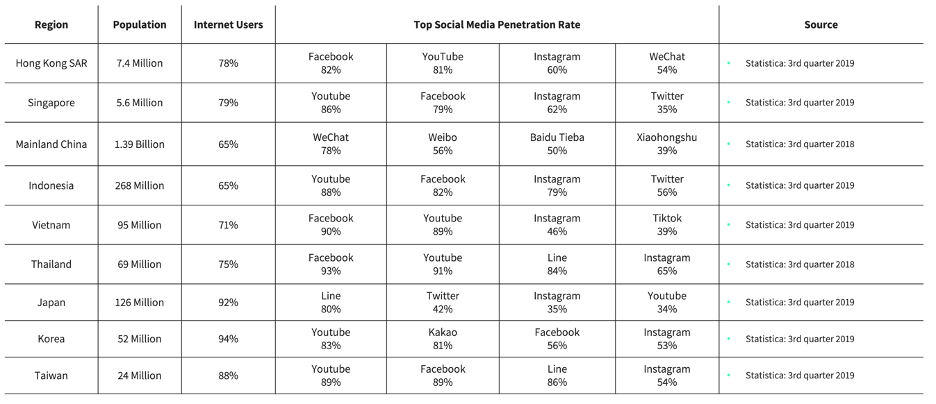While the digital economy has continued to prosper, there are signs that global tensions may cause social media protectionism to rise.
Protectionism refers to the policy of protecting domestic industries, against foreign competition. In the Social Media world, this could be done by developing strong domestic platforms or applying barriers to digital channels. Barriers could include localization measures, regulations to protect privacy, and even censorship.
The biggest sign of this can be seen from President Trump issuing two executive orders against China-based TikTok and messaging app WeChat. President Trump cited national security concerns, that could prevent social media platforms from accessing the United States Market.
Although social media protectionism, and countries promoting their own nationally-built social channels, isn’t a new phenomenon. It is something that is likely to advance over the next few years.
Read on to discover the acceleration in social media protectionism.

Digital and social media environments in Asia
From 2010, the Digital World was already fragmented through 5 major Digital & Social Media environments.
4 of these 5 ecosystems were already present in Asia:
- Western ecosystem: Google, Amazon, Facebook, etc.
- China ecosystem: Baidu, Alibaba, Tencent, Xiaomi, etc.
- South Korea ecosystem: KakaoTalk & Kakao Story (81%), Naver, etc.
- Japan ecosystem: Line (80%)
- Russia: VKontakte (83%), Odnoklassniki (54%)
We still observe a strong presence of Western channels alongside national channels.
In Vietnam, Facebook remains the most popular social media (90%). While in South Korea, YouTube has a very high penetration rate (83%).
As well as Instagram (56%) & Facebook (53%). (Source of penetration rate: Statista)
Social Media protectionism has been accelerated
Across Asia, native platforms are dominating local markets, despite pressure from giants like Facebook:
2010 in South Korea: KakaoTalk is a free mobile instant messaging application with free text and free call features.
Operated by Kakao Corporation, it was launched in 2010.
2011 in Japan: LINE is a freeware app for instant communications.
LINE is a platform providing various services. This includes digital wallet – Line Pay, news stream – Line Today, video on demand – Line TV, and digital comic distribution as Line Manga and Line Webtoon. Line Corporation is a subsidiary of a Korean internet search engine company, Naver Corporation.
2019 in Vietnam: The Vietnamese government promotes the development of social media networks in local spaces.
This is done through ‘The Digital Vietnamese Knowledge Platform’. An open platform that provides government data and infrastructure for citizens to develop apps and other software (Data61 2019).
Today, there are 11 different Social Media platforms identified among the TOP 5 countries in Asia (excluding Messenger Technologies).

Why support Social Media protectionism measures?
Governments are willing to promote national Social Media for several reasons:
- Economy: A social media with a large audience provides substantial potential for national revenue.
The advertisers are targeting a local market, the audience is local. Therefore, the Ad revenue escapes national GDP, and tax, if the channel is foreign. The government is actively supporting national social media to curb this problem. - Data security & national security: These two topics are probably the most sensitive. With major economies willing to implement strong measures to protect their national sovereignty. Data security is often used as a sub-pattern to reinforce security & censorship.
- Diplomacy: A strong national social media is a strategic way to limit dependence on Social Media controlled (and/or influenced) by other governments. Social Media is part of the daily communication & media journey of billions of people. Countries are anticipating potential future pressure from other countries by limiting foreign social media dependency.
Examples of Social Media Protectionism in Asia:
Vietnam:
Vietnam was ranked one of the ten most censored countries worldwide (Sherman 2019). The government has introduced restrictions, such as firewalls, list blocking, and legal compliance on social networks (Bui 2016).
The Information Minister has also encouraged firms to “create viable domestic alternatives to foreign social media platforms, which are more difficult for the government to control” (Reuters 2019). The aim is for 50% of Vietnam’s social media users to use “domestic social networks” by 2020. Therefore, preventing “toxic information on Facebook and Google” (Reuters 2018).
Indonesia:
Social media is known as “the fifth estate in Indonesia’s democracy’. It has been used extensively in political party campaigns and in the successful pursuit of social movements. Therefore, to curtail the spread of fake news after the 2019 electoral riots, the Indonesian government partially restricted access to YouTube, WhatsApp, Facebook, and Instagram (Müller 2020).
Singapore:
On 8 May 2019, Singapore’s parliament passed a new act to regulate the spread of fake news in Singapore. As a result, the Protection from Online Falsehoods and Manipulation Act (POFMA) came into effect on 2 October 2019.
Read our article: Singapore Fake News Act: A guide to POFMA
Thailand:
On 25 September 2020, Thailand sues Facebook, Twitter for allowing banned material. Thailand’s government lodged complaints with police Thursday against Facebook and Twitter, alleging they failed to comply with court orders to block content judged illegal under Thai law.
More information: On this link
How to be agile to changing digital landscape
In such a complicated Asian Landscape, brands should anticipate this new era by carefully navigating Social Media.
Soon, borders could separate countries digitally as it has always done physically.

Strategy:
- A good marketing, digital, and social media strategy have to take into consideration the complexity of this world.
- Understanding people, ecosystems, and the capabilities of the platforms you are targeting, has never been more important.
- A strategy organized through a clear market per market and channel per channel sequences is a must.
- You need to learn, test, and validate each operational initiatives in a very humble and pragmatic way. Therefore comprehensive and precise quantitative and qualitative KPIs definition should come first.
Culture:
- It’s essential to have a deep understanding of cultural habits and social media uses
- In the growing Asian economy, Facebook is often the most popular social media for networking and for selling goods. Whilst Facebook is more commonly used as an entertaining and content sharing platform in a more mature economy.
Timing:
- However, don’t confuse speed with haste. In addition, initiate Asian social media development by dedicating significant efforts and time. Above all, it’s important to understand technical, cultural specificities, and complexity of the country you wish to target.
Explore our other Market Research in Asia:
- ① Cultural social media insights in Singapore
- ② Social media marketing in Singapore
- ③ Online marketing in Singapore
- ① Cultural social media insights in Vietnam
- ② Social media marketing in Vietnam
- ③ Online marketing in Vietnam



